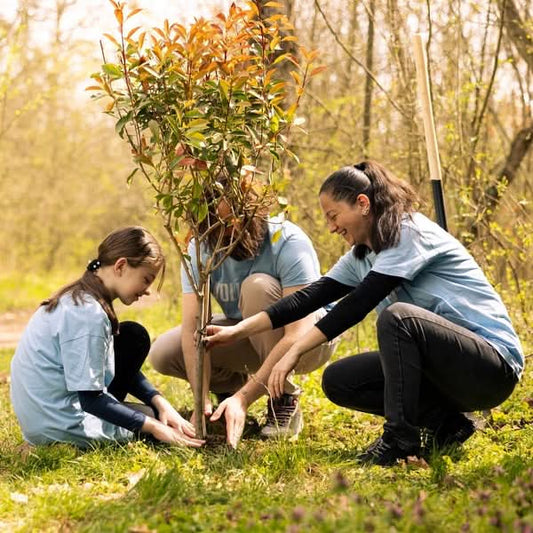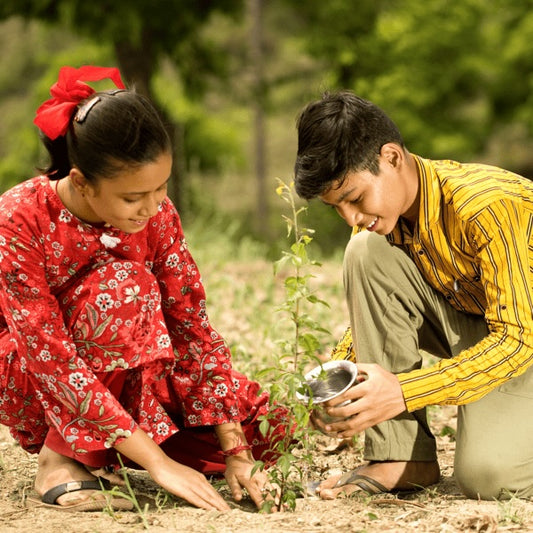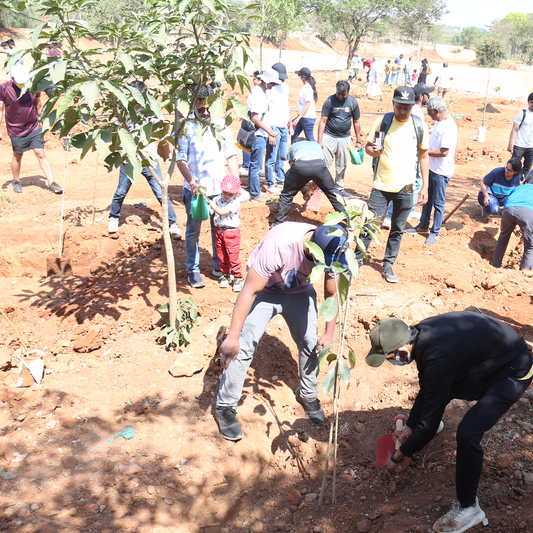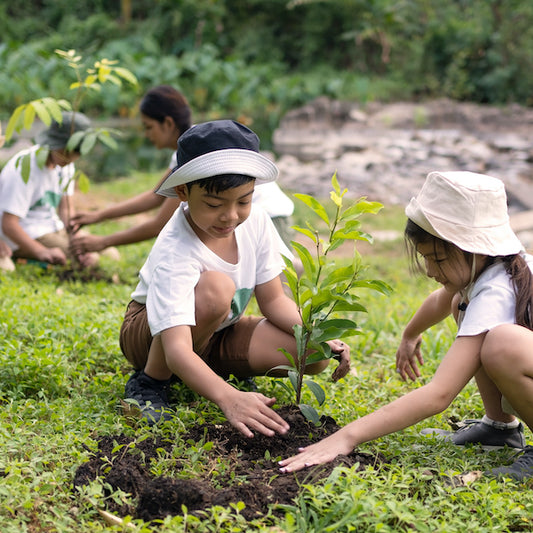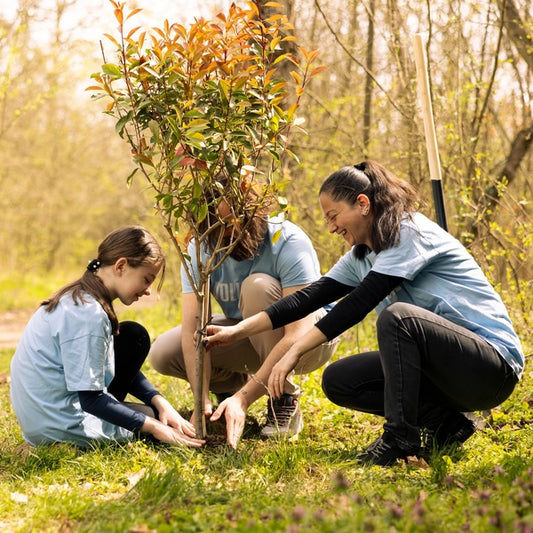Deep Roots, Strong Teams: ProcDNA's Employee-Driven Green Initiative
ProcDNA, a cutting-edge procurement analytics platform known for leveraging AI and data science to optimize procurement processes, has extended its fo Read more
Project Update 3

Project Update 2













Project Update 1





Digital Forest
Forest with 100 Trees planned
Want to plant your tree now?
Plant a Tree @ 299Deep Roots, Strong Teams: ProcDNA's Employee-Driven Green Initiative
ProcDNA, a cutting-edge procurement analytics platform known for leveraging AI and data science to optimize procurement processes, has extended its forward-thinking approach to environmental sustainability. In collaboration with its employees, the company recently organized a tree plantation initiative rooted in the Urban forest concept, a method known for rapid growth and dense, native forests that rejuvenate ecosystems.
This employee engagement event was more than just planting trees; it was about planting values. The initiative aimed to foster a culture of environmental responsibility while promoting team bonding and a shared commitment to the organization's purpose. Employees got their hands muddy and hearts full as they took part in the restoration of green spaces together.
By embracing the urban plantation method, ProcDNA ensures long-lasting ecological impact, contributing to biodiversity, carbon sequestration, and climate resilience. This green effort not only reflects the company’s commitment to climate action but also provides employees with a deeply rewarding, hands-on experience in building a more sustainable future. Through this initiative, ProcDNA is creating forests and forging deeper roots between people and the planet.
Project Planning & Execution
No of Trees: 100
Plantation Location: 602, Block A, Phase 1, Sushant Lok, Gurugram, Haryana, 122001
Plantation Date: 4th August 2025
Beneficiaries Details
-
Target Population: Employees, stakeholders, and local community members of Gurugram.
-
Age Group: Inclusive of all age groups, ensuring broad community participation.
-
Gender: Inclusive of all genders.
- Social & Economic Status: Open to all social and economic backgrounds, emphasizing community involvement.
Planting Methodology and Its Advantages
Urban Forest: An urban forest is a network of trees, shrubs, and vegetation strategically planted in urban areas to enhance biodiversity, improve air quality, reduce the urban heat island effect, and provide green spaces for community well-being. It helps mitigate climate change by absorbing carbon dioxide, promotes mental health through accessible green areas, and supports local wildlife by creating habitats. Urban forests play a vital role in building resilient, sustainable cities that benefit both the environment and the people who live in them.
Advantages of Urban Forest
-
Climate Regulation and Cooling Effect: Urban forests help mitigate the urban heat island effect by providing shade and cooling through transpiration, lowering temperatures in cities, reducing the need for air conditioning, and conserving energy.
-
Improved Air Quality: Trees absorb pollutants such as carbon dioxide, nitrogen oxides, and particulate matter, leading to improved air quality and a reduced risk of respiratory illnesses in urban areas.
-
Stormwater Management and Flood Prevention: Urban forests improve the soil’s ability to absorb and retain water, reducing stormwater runoff, preventing flooding, and promoting groundwater recharge, thus helping manage water resources efficiently.
-
Soil Erosion Control: The deep root systems of trees prevent soil erosion, especially in areas with heavy rainfall or steep slopes, stabilizing the land and reducing soil loss in urban environments.
-
Aesthetic and Recreational Value: The transformation of unused spaces into green zones adds aesthetic value to the area and provides employees and local communities with recreational spaces, making the workplace more enjoyable.
-
Enhanced Community Engagement and Well-being: Urban forests provide accessible green spaces where communities can engage in recreational activities, improving mental health, reducing stress, and fostering a sense of environmental stewardship among residents and employees.
-
Increased Property Value: Properties located near urban forests or green spaces tend to have higher market values, benefiting local property owners and increasing the overall appeal and livability of the area.
- Noise Reduction: Urban forests act as natural sound barriers, reducing noise pollution and creating quieter, more peaceful surroundings.
Conclusion Elements
Impact
Indirect Impact
Community Impact
-
Improved Public Health: By improving air quality and reducing urban heat, the project indirectly contributes to better public health. The presence of green spaces encourages outdoor activities, which can reduce stress levels, promote mental well-being, and decrease the incidence of respiratory diseases.
-
Environmental Awareness: Involving communities in urban forestry raises awareness about environmental conservation and promotes sustainable practices in daily life.
-
Employee Morale: The initiative fostered a sense of pride and connection among employees, strengthening team bonds and their alignment with the company’s values.
-
Inspiration for Change: By showcasing the potential of urban forestry, the project has encouraged other organizations and local communities to undertake similar initiatives.
- Cultural Shift: The initiative instilled a mindset of sustainability and environmental care among participants, creating advocates for green practices in their personal and professional lives.
Environmental Impact
-
Carbon Sequestration: The trees planted through ProcDNA's urban forestry initiative absorb carbon dioxide, acting as carbon sinks and helping mitigate climate change by reducing greenhouse gas emissions.
-
Soil Health Improvement: The tree planting initiative enhances soil health by enriching it with organic matter, improving soil fertility and structure, which supports the growth of surrounding vegetation.
-
Erosion Prevention: Tree roots help stabilize the soil in urban areas, preventing erosion caused by wind and water, while safeguarding nearby properties and infrastructure from potential damage.
-
Biodiversity Conservation: By creating green spaces, the initiative supports local biodiversity, providing habitats for various species, pollinators, and beneficial insects, and enhancing the ecological balance in urban areas.
-
Water Cycle Regulation: The urban forestry project helps regulate the water cycle by improving water retention in the soil, recharging groundwater levels, and reducing surface runoff, leading to a more balanced and sustainable urban environment.
-
Microclimate Regulation: Trees planted through this initiative moderate temperature extremes, reduce wind speeds, and increase humidity, creating a favorable microclimate for both the community and the urban ecosystem.
Achievements
SDG Goals Achieved Through Urban Forest
-
SDG 3: Good Health and Well-Being: ProcDNA's urban forestry initiative improves air quality and introduces green spaces that support physical and mental well-being. These natural environments help reduce stress, encourage outdoor activity, and foster healthier lifestyles in urban settings.
-
SDG 6: Clean Water and Sanitation: Through tree planting, ProcDNA promotes water conservation by aiding groundwater recharge, reducing runoff, and enhancing soil moisture retention, contributing to sustainable urban water systems.
-
SDG 7: Affordable and Clean Energy: By reducing the urban heat island effect, the plantation helps moderate city temperatures and decrease dependence on energy-intensive cooling systems, thus promoting energy efficiency and sustainability.
-
SDG 8: Decent Work and Economic Growth: The initiative creates green jobs in nursery management, plantation, and ecosystem maintenance, supporting local livelihoods and advancing the green economy.
-
SDG 9: Industry, Innovation, and Infrastructure: ProcDNA incorporates sustainable green practices into urban infrastructure, showcasing innovative approaches that integrate technology with environmental resilience.
-
SDG 10: Reduced Inequalities: The initiative is inclusive, involving employees from all backgrounds in environmental action. By developing accessible green zones, ProcDNA ensures shared environmental and health benefits across communities.
-
SDG 11: Sustainable Cities and Communities: By increasing green cover and enhancing biodiversity in dense urban areas, ProcDNA contributes to building sustainable, resilient, and livable cities.
-
SDG 12: Responsible Consumption and Production: ProcDNA's eco-initiatives reflect a commitment to sustainable practices, emphasising efficient use of resources and long-term ecological responsibility.
-
SDG 13: Climate Action: The planted trees help sequester carbon dioxide, reduce emissions, and buffer against climate change impacts, actively supporting global climate goals.
-
SDG 15: Life on Land: By restoring green spaces with native and fruit-bearing trees, the initiative strengthens biodiversity, supports wildlife, and contributes to a thriving urban ecosystem.
-
SDG 16: Peace, Justice, and Strong Institutions: By fostering inclusive decision-making and community-led governance, ProcDNA strengthens local environmental stewardship, ensuring transparency and collaboration for sustainable urban development.
-
SDG 17: Partnerships for the Goals: The initiative thrives on collaboration with local communities, environmental organizations, and partners such as Grow Billion Trees. ProcDNA strengthens environmental partnerships to drive impactful urban sustainability and afforestation efforts. future.
ESG Achieved through Urban Forest
-
Environmental Impact: ProcDNA's urban forestry initiative makes a meaningful contribution to environmental sustainability. By planting a diverse mix of native and beneficial tree species, the company enhances local biodiversity, supports pollinators and wildlife, and strengthens urban ecosystems. These trees act as natural carbon sinks, helping to reduce atmospheric CO₂ levels and combat climate change. Additionally, the plantation improves climate resilience by regulating ambient temperatures, reducing the urban heat island effect, improving air quality, and increasing groundwater recharge. This forward-looking effort supports long-term ecological balance and a healthier environment for future generations.
-
Social Impact: ProcDNA's urban forestry initiative fosters social responsibility and community well-being by involving employees and local stakeholders in environmental stewardship. Through active participation in tree planting and awareness efforts, the initiative cultivates a deeper connection with nature and promotes collective action for sustainability. The creation of green spaces improves air quality, encourages outdoor activity, and contributes to better mental and physical health. Additionally, the project supports green jobs through sapling plantation and ongoing maintenance, while promoting inclusivity by ensuring access to cleaner, greener environments for all communities, including underserved groups. This initiative helps build a more resilient, equitable, and environmentally conscious society.
- Governance Impact: ProcDNA showcases strong environmental leadership and responsible governance through its urban forestry initiative. By integrating sustainability into its employee engagement strategy, the company promotes transparency and accountability in project planning, execution, and reporting. Collaborating with environmental organizations and local communities, ProcDNA ensures that its afforestation efforts are inclusive, impactful, and aligned with broader ecological goals. This governance approach not only supports environmental and social outcomes but also reflects the company’s long-term vision for sustainable growth and ethical corporate responsibility.
Building Communities
One of the most profound impacts of ProcDNA's urban forest initiative has been the spirit of unity and collaboration it fostered. By actively involving employees, local communities, and volunteers, the project became more than just a tree plantation drive; it evolved into a shared mission to create resilient and sustainable green spaces. This collective effort has strengthened environmental consciousness and encouraged long-term stewardship of natural resources.
-
Empowering Communities: This initiative actively engages employees and stakeholders in the planting and maintenance processes. This involvement fosters a sense of ownership over the green spaces, empowering individuals to take responsibility for their environment. As participants contribute to the growth of their community’s green cover, they become more connected to their surroundings, building pride and a shared commitment to sustainability.
-
Fostering Meaningful Partnerships: The initiative brought together key stakeholders, including ProcDNA, Grow Billion Trees, and local communities, demonstrating the power of collaboration in achieving lasting environmental and social change. These partnerships strengthened the collective commitment to sustainability, ensuring that afforestation efforts continue to thrive in the long run.
-
Inspiring a Ripple Effect: As the benefits of the afforestation project became evident, improved air quality, enhanced biodiversity, and increased community engagement, its impact extended beyond the immediate planting site. Local communities and organizations have been inspired to replicate similar initiatives, amplifying the project's reach and reinforcing the importance of urban greening.
This initiative exemplifies that true environmental sustainability is not just about planting trees; it’s about nurturing awareness, fostering collaboration, and creating a shared vision for a healthier, greener, and more sustainable future.
Commitment by Grow Billion Trees
Trees for Corporates
Trending
Most Popular
Employee Engagement through Urban Forestry
ProcDNA’s urban forest initiative isn’t just about planting trees—it’s about growing a forest of teamwork, one sapling at a time! Employees didn’t just attend a tree plantation drive; they attended a green bonding retreat with Mother Nature herself. This initiative added a layer of soil (and soul) to employee engagement. From digging pits to planting native species, the team turned into eco-warriors for a day. Turns out, the best way to brainstorm is under the shade of a freshly planted Jamun tree. By encouraging employees to connect with the environment, ProcDNA fostered a new kind of office ecosystem—one where performance reviews are shaded by trees and lunch breaks come with chirping birds. This green day out was not just fun—it reinforced values of responsibility, sustainability, and collaboration. And let’s face it, nothing boosts morale like being able to say, “That’s my tree growing over there.” Employee engagement? Check. Urban impact? Check. Oxygen? Oh yes, double check.
Sustainable CSR Initiatives
growth isn’t just about revenue curves, but also canopy cover. Native and fruit-bearing trees were planted to reclaim green spaces, restore biodiversity, and revive city lungs. Every sapling planted is a living, photosynthesizing press release saying, “We care!” This isn’t just CSR, it’s GSR—Green Social Responsibility. Urban forests are the future, and ProcDNA is among the first to give it roots, literally. When your CSR program gives back to the planet, provides shade, and smells like fresh soil—now that’s next-level corporate cool.
Urban Biodiversity Restoration
When ProcDNA plants trees, they’re not just growing wood—they’re rebooting the city’s biodiversity matrix. Birds, bees, bugs—welcome back, your treehouses are ready! Urban biodiversity isn’t a luxury anymore; it’s a necessity. And ProcDNA’s urban forest is bringing that buzz back (quite literally). Carefully selected native and pollinator-friendly species were planted to reintroduce ecological balance in a space once claimed by concrete. Think of it as the comeback tour for butterflies and sparrows. Every tree planted is a new apartment for wildlife and a standing ovation for nature. The urban jungle has enough traffic—now it’s time for some chirping, fluttering, and rustling. By restoring biodiversity, ProcDNA is rebooting the natural networking system that helps ecosystems thrive. So while other companies focus on digital ecosystems, ProcDNA is restoring the original one—with roots, wings, and chlorophyll.
Climate Action by Corporates
ProcDNA is proving that climate action can be cool, corporate, and completely chlorophyll-filled. As climate change knocks louder, ProcDNA has responded with a green shield—urban forests! Instead of hosting another seminar on carbon emissions, they went ahead and sequestered some. With each tree planted, carbon found a long-term parking spot in the form of a leafy resident. It's like offsetting, but with more dirt under the fingernails. Their plantation drive is climate action with flair—real action, real trees, real impact. Trees lower urban temperatures, improve air quality, and absorb those sneaky CO₂ molecules. Who knew fighting global warming could be this photogenic? By turning rooftops and barren lands into micro-climate warriors, ProcDNA isn’t just going green; they’re going heroic. Mother Earth approves, and so does SEO.
Green Corporate Culture
In the forest of corporate values, ProcDNA is planting ‘green’ right at the center. Literally. The urban forest initiative isn’t just about sustainability—it’s about reshaping company culture from spreadsheets to seedbeds. Here, green isn’t just a color on the logo, it’s a living, breathing value growing on company time. When employees gather to plant trees, something magical happens—titles disappear, teamwork blooms, and everyone’s in it for the roots. It’s HR-meets-Nature, where the only KPI is ‘kilograms of carbon absorbed.’ With this initiative, ProcDNA is showing that being eco-conscious isn’t a seasonal policy—it’s an everyday practice. So whether you're a coder, analyst, or intern, there’s now a tree out there with your name (and sweat) on it. This is what a truly modern corporate culture looks like—rooted in purpose, watered with collaboration, and branching into the future.
Native Tree Plantation
ProcDNA’s not planting just any trees—they’re going native, like a pro. In a world obsessed with exotic and ornamental, the company made the bold (and wise) choice to embrace local biodiversity. Neem, Jamun, Arjun, Karanj—these aren’t just tongue-twisters, they’re climate-resilient superheroes! Native trees grow better, support local ecosystems, and require less maintenance—a perfect ROI for environmental stewardship. Unlike imported species, these trees know the lay of the land and thrive in their hometowns. ProcDNA’s choice to prioritize indigenous plantation reflects a deeper understanding of sustainability. It’s like hiring local talent—except these hires work 24/7, produce oxygen, and never ask for a raise. Plant native, grow smarter, and keep your city shady (in a good way).
Tree Plantation for Healthier Cities
Who needs air purifiers when your city has an urban forest? ProcDNA’s plantation initiative wasn’t just about going green—it was about making cities breathable again. As traffic fumes choke city lungs, trees are the leafy lungs we desperately need. ProcDNA’s answer? Add more trees, not air fresheners. Each planted sapling is a little air filter with roots. With every Neem and Peepal planted, they’re tackling air pollution the natural way—no electricity required. Trees cool the air, trap pollutants, reduce noise, and make morning walks bearable again. The result? Healthier employees, happier residents, and a city that smells less like exhaust and more like forest dew. This is not just urban forestry—it’s urban first-aid.
Corporate Environmental Responsibility
CSR is passé. Meet CER—Corporate Environmental Responsibility—and ProcDNA is crushing it! The urban forest project isn’t a photo-op; it’s a declaration of values. By making environmental action a company-wide responsibility, ProcDNA is leading by example. This isn’t a tree-planting selfie moment—it’s a leafy legacy. From selecting ecologically sound species to executing a well-planned plantation drive, ProcDNA ensured that every green move counts. And it’s not just top-down—it’s roots-up, involving employees and partners alike. CER means walking the eco-talk, and ProcDNA’s footprints are now green, not carbon. Other companies might recycle emails; ProcDNA recycles CO₂ into oxygen. Because in today’s world, saving the planet is no longer optional—it’s just good business.
FAQ
What is ProcDNA’s role in promoting tree plantation in India?
ProcDNA actively supports tree plantation as part of its environmental sustainability and CSR initiatives. Through partnerships and employee-driven plantation drives, ProcDNA contributes to creating greener, healthier urban spaces. Our urban forest projects focus on planting native and climate-resilient trees that support biodiversity, sequester carbon, and restore ecological balance. This initiative aligns with our long-term commitment to reducing our environmental impact and giving back to the communities we work in.
How does ProcDNA's urban forest initiative help Indian cities?
ProcDNA’s urban forest initiative helps Indian cities by increasing green cover, improving air quality, and promoting biodiversity. By transforming underutilized spaces into thriving tree canopies, we create natural habitats, reduce urban heat islands, and provide a serene environment for people and wildlife. Our plantations are designed with native species that thrive locally and require minimal maintenance. This initiative is part of our mission to build sustainable cities and contribute to India’s fight against climate change.
Why is employee involvement important in ProcDNA’s tree plantation drives?
Employee involvement in tree plantation enhances engagement, strengthens team spirit, and promotes environmental responsibility. At ProcDNA, we believe true impact begins with internal change. When employees participate in urban forest drives, they develop a deeper connection with sustainability goals and become advocates for green living. These activities also foster a sense of pride and ownership, making our green initiatives more meaningful, impactful, and long-lasting—benefiting both people and the planet.
What types of trees does ProcDNA plant during its urban forestry drives?
ProcDNA prioritizes planting native, fruit-bearing, and climate-resilient species during its urban forestry drives. These include Neem, Jamun, Karanj, Kadamba, Peepal, and Indian Cork Tree. Native trees are better adapted to the local environment, support biodiversity, require less maintenance, and contribute significantly to ecological balance. By choosing the right species, we ensure long-term survival of the trees while improving the overall environmental health of the region.
How does ProcDNA ensure the long-term success of its plantation efforts?
ProcDNA focuses on sustainability beyond planting. We collaborate with local experts and ecological partners to select suitable sites, prepare the land, and plant the right mix of species. Post-plantation care, such as watering, mulching, and monitoring, is handled by trained teams to ensure high survival rates. This end-to-end approach helps us create lasting green ecosystems that thrive over time and contribute to our environmental goals.
Is ProcDNA’s tree plantation part of a larger CSR strategy?
Yes, ProcDNA’s tree plantation initiative is a vital part of its broader Corporate Social Responsibility (CSR) strategy. It complements our focus on environmental sustainability, climate action, and community engagement. By investing in urban forestry, we not only mitigate our ecological footprint but also enhance public well-being, support local biodiversity, and align with global sustainability goals like the UN SDGs. It’s CSR with roots—literally.
How do ProcDNA’s urban forests contribute to carbon reduction?
Urban forests planted by ProcDNA help capture and store atmospheric carbon dioxide, reducing greenhouse gases and mitigating climate change. Each tree acts as a natural carbon sink, improving air quality and cooling urban temperatures. By planting thousands of native trees, ProcDNA contributes to offsetting its carbon footprint, supporting India’s climate goals, and creating cleaner, healthier cities for the future.
Can ProcDNA’s plantation model be replicated in other cities?
Absolutely. ProcDNA’s urban forest model is scalable and adaptable across Indian cities. By focusing on local species, community involvement, and sustainable maintenance, the model can be replicated in urban parks, corporate campuses, schools, and public spaces. We are open to collaborations and knowledge-sharing to encourage more green projects across India and inspire collective climate action through corporate and civic partnerships.
What are the benefits of urban forests for communities?
Urban forests provide numerous benefits to communities including cleaner air, lower temperatures, noise reduction, mental well-being, and enhanced biodiversity. ProcDNA’s initiatives create green spaces where people can connect with nature, promoting healthier lifestyles and community pride. These forests also act as educational tools, inspiring environmental awareness among citizens and children. Overall, they make cities more livable and resilient.
How can others collaborate with ProcDNA for tree plantation initiatives?
Individuals, organizations, and institutions interested in partnering with ProcDNA for tree plantation initiatives can reach out through our website or corporate social channels. We welcome collaborations that promote environmental stewardship, employee engagement, and sustainable development. Whether it's co-hosting plantation drives, sponsoring trees, or sharing best practices, we believe collective action can make a bigger, greener impact.
- Choosing a selection results in a full page refresh.
- Opens in a new window.



